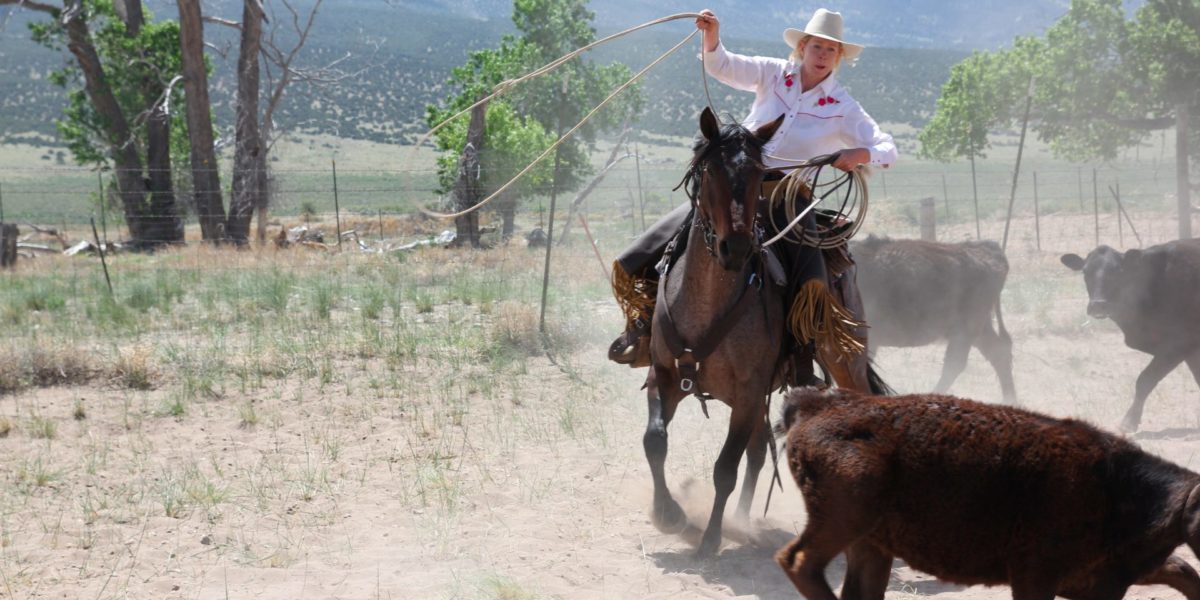
Zapata Ranch: Shirkers Need Not Apply
Author and friend of All Roads North, Laura Kaye, pays a visit to Colorado’s Zapata Ranch and gets a little more than she bargained for:
By sheer chance, my visit to Zapata Ranch coincided with branding day. This is really the only time that ranch workers interfere with the cattle – the rest of the time the herds are free to roam and graze on the grasslands and the only job is to move them from pasture to pasture – so I was extremely lucky that my visit should include the most exciting event of the ranching year.
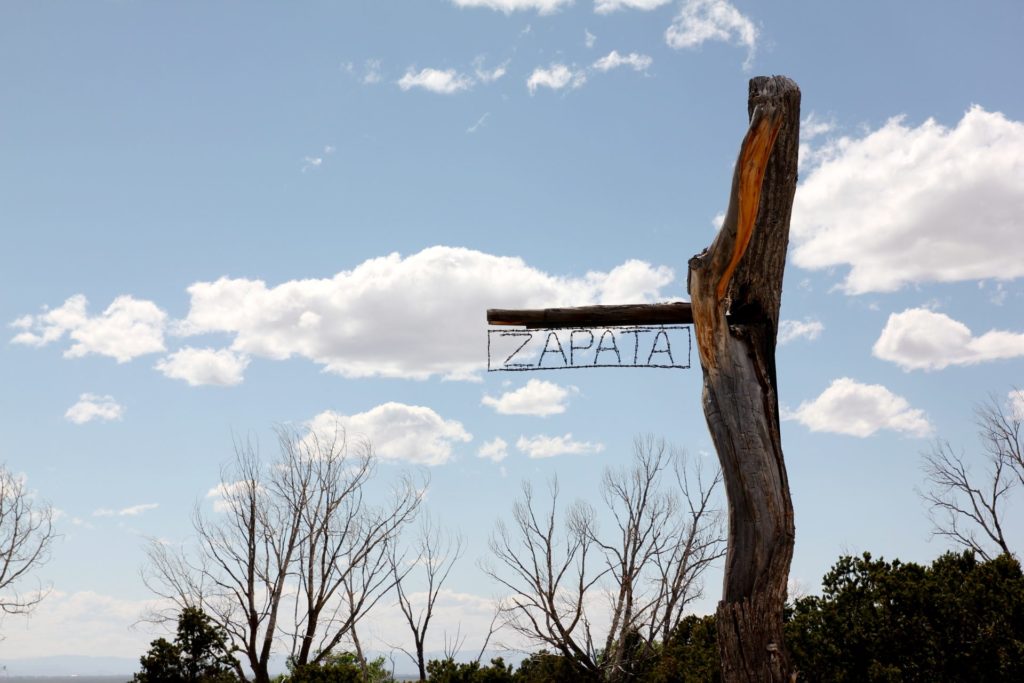
Welcome to Zapata
Zapata Ranch is in southwest Colorado on a vast plain flanked by the Sangre de Cristo mountain range. The land is owned by the Nature Conservancy, a high-profile organisation preserving natural wildernesses, and the cattle are raised by Ranchlands, a company that manages several ranches in the American Southwest. It is an interesting model that works on the basis that both parties want the same thing: to maintain the landscape and preserve ranching, not just as a profitable business but also as one of the great American traditions.
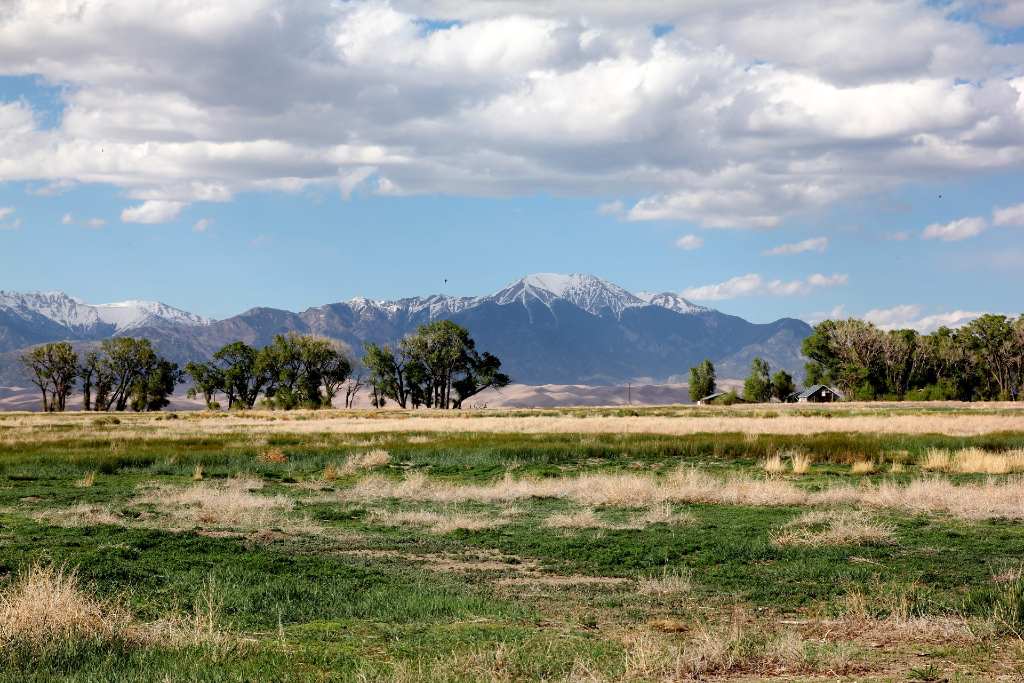
The Sangre de Cristos Mountains are never far from view
On the morning I am due on the ranch, I set off from Denver and drive four hours south. It is a beautiful drive with vistas of snow-capped mountains on the horizon that grow bigger, then shift, giving way to yet more mountains. After I arrive and am shown to my room (simple, Western luxury), I walk around the grounds, dazed by the views of mountains in all directions across the plain. At dinner I meet my fellow guests and some of the wranglers. There are around ten guests and they have come from all over the country to experience life on a ranch. So too have the wranglers, chosen from hundreds of applicants for their skills in horsemanship and their stamina. Interestingly they are all female, which the manager Kate tells me is not by design, just default since the men who applied couldn’t quite cut the pace. It is a hard job and she admits that it can be tough balancing high end hospitality with long hours of physical work. Part of the Ranchlands’ holistic managerial approach is to move the staff around, to promote them and give them new opportunities in the growing business rather than allowing anyone to get burnt out by the constant four AM starts.
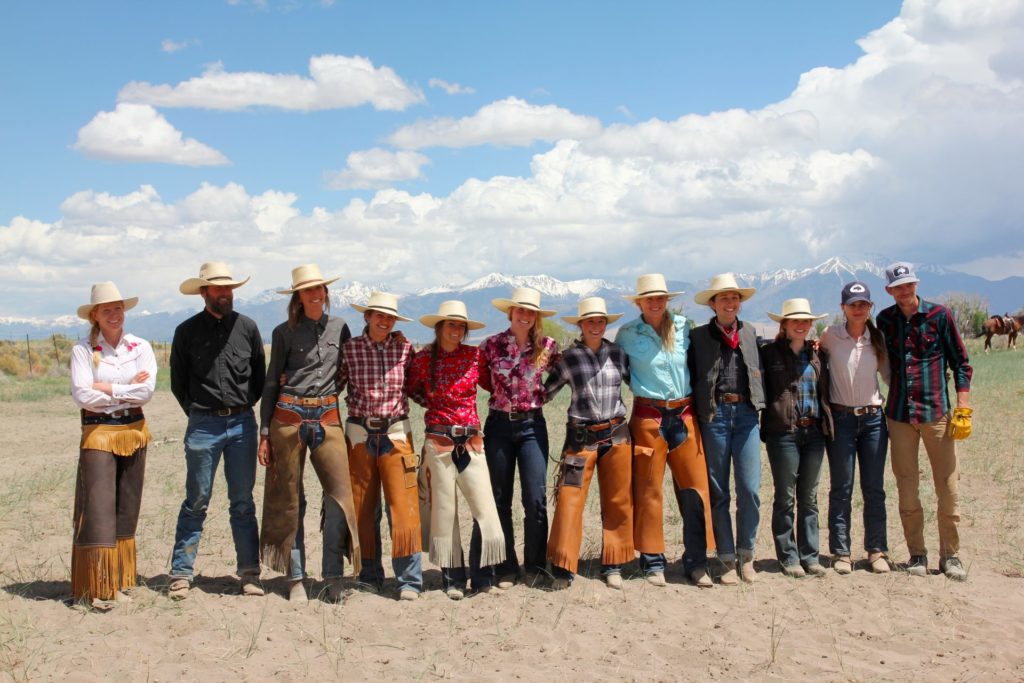
Girl Power at Zapata Ranch
The next morning, at six, we set out for the corral. My horse is waiting for me. I am a bit apprehensive given that I haven’t ridden since I was fifteen. My worries are not calmed when I find out that my horse’s name is ‘Speedy,’ though I tell myself it is probably ironic. I decide that he looks like a good horse. Big Em, one of the wranglers, gives me a quick lesson in how to ride western style. The only real difference is that you hold the reins in one hand and tap them against the horse’s neck when you want to turn. It doesn’t seem too hard and Speedy seems to know what he is doing. Then we are off, riding out into the grasslands where we split into two groups: those who feel up to it will ride further and faster and those, including me, who want to take it easier will round up the cattle closest by.
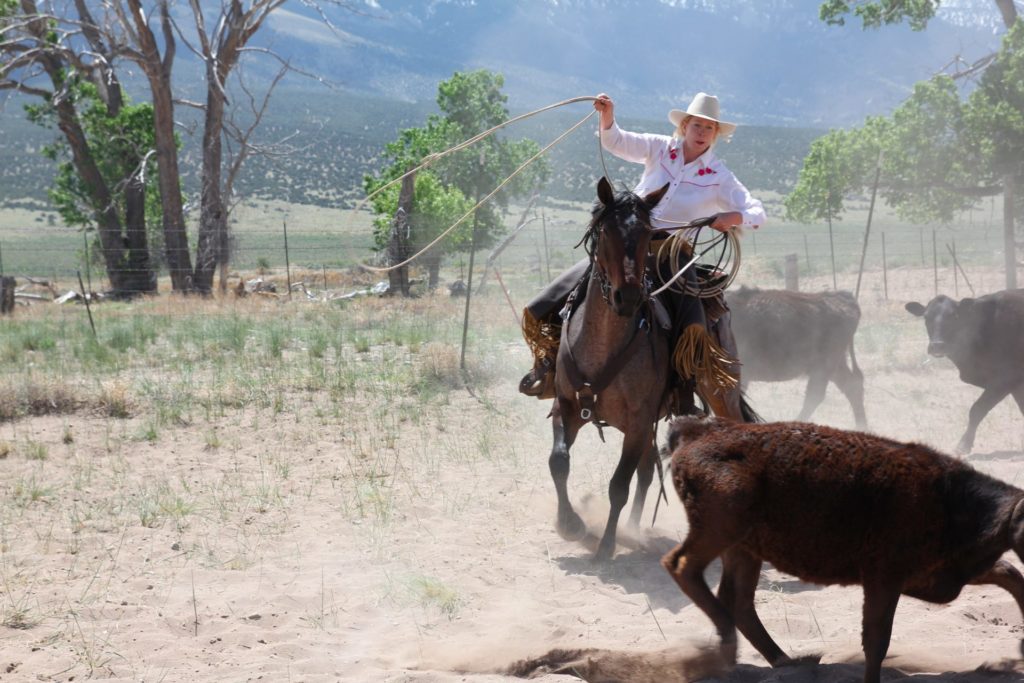
One of the Ranch Managers, Kate Matheson, in action
In my group there are three guests and three wranglers and we ride along the fence and split into twos in order to cover maximum ground. I am paired with Kaitlyn, another of the wranglers. We head into the middle of the field, walking in a line parallel with the mountains until we come across a small herd of forty or so cows. We start to push them towards the other side of the field but Kaitlyn shouts over to me that she wasn’t expecting this many cows. ‘You keep going,’ she tells me before galloping off to find some more riders to help. Suddenly I am alone with nobody else in sight. I realise that I am herding the cattle, just me. Whatever I was expecting from my stay on a ranch, I was not expecting this. I thought I would mostly be watching experienced cowboys doing their thing and occasionally being allowed to do some minor and unimportant job so that I would feel like I was part of it. So it was a genuine thrill to find myself left in charge of these cattle and I did my best not to lose any of them, circling back to pick up any strays, until Kaitlyn returned with back up.
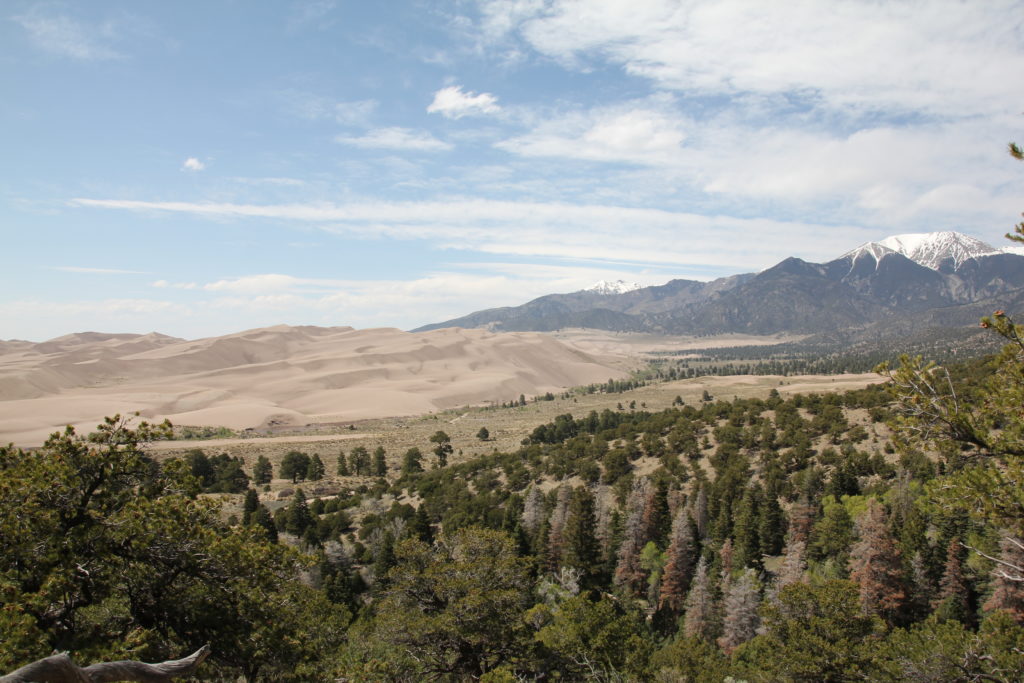
Where sand dunes and mountains meet
The next day there are no cattle related jobs so a few of us go on a ride through the Medano pastures with its artesian wells, streams and wild irises to hopefully get a glimpse of the herd of two thousand wild bison that roam there. Like the cattle, they are left alone except for one day in November when they are rounded up and the young are counted and vaccinated and the bison that are used for meat are taken to maintain the number of the herd. We are warned that we might not be lucky enough to see them, but we end up so close to the herd that we have to move back as they cross the stream in front of us. It is quite a sight. And especially, I realise, for the others, being American, who have a difficult and painful history with these creatures so nearly hunted to extinction by settlers.
In the afternoon we are taken on a walk with John, the ranch’s on-call naturalist, to the Great Sand Dunes National Park where giant dunes like you would find in the Sahara have been deposited by the wind at the base of the Sangre de Cristos. John knew everything about every plant and its uses for Native Americans as well as taking us to an archaeological site where forty-five bison were processed for meat by a nomadic tribe who used to come through this vast valley.
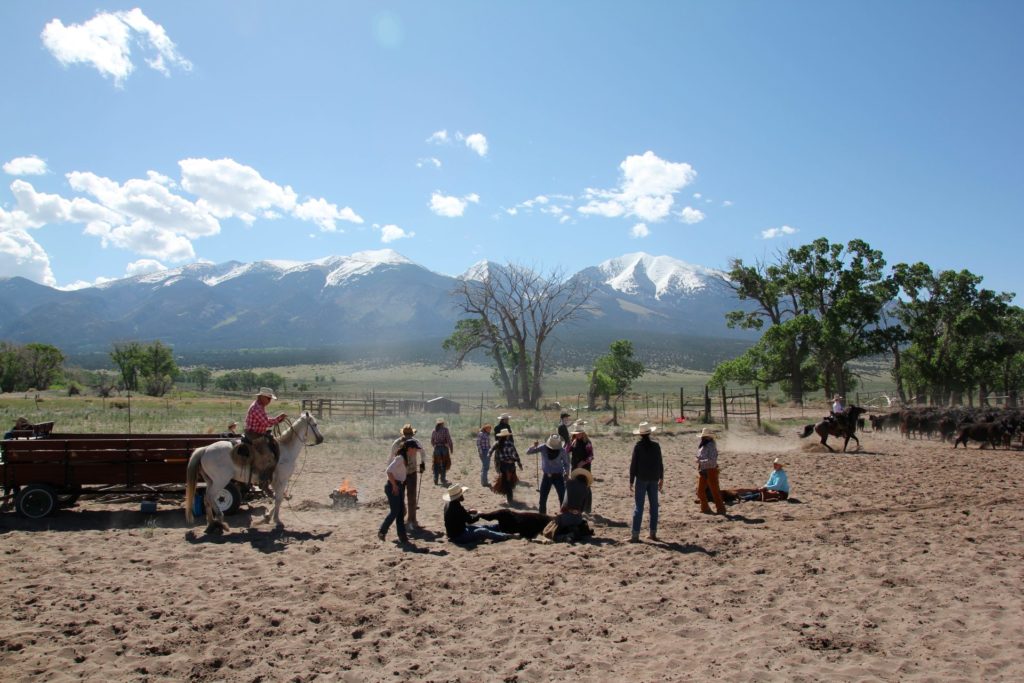
Cattle branding is a team sport
The next day is branding day. We have to be up at six again. Everyone rides out to the pastures to bring the cows into the corral. Workers from other ranches managed by Ranchlands have come to help out. There is a festive air. The wranglers are wearing their best shirts and tasselled leather chinks (like chaps but with straps to stop them getting too hot). A wagon has been parked in the middle of the corral and a fire lit to heat the branding irons. Duke, the owner of Ranchlands, and Kate, a manager at Zapata, are on horseback, the rest of us are on foot, our horses tied up at the fence. We are given instructions and roles: wrestling the calves to the ground, ear tagging or vaccinating. Then it begins: Kate and Duke make their way over to the cows at the end of the corral and they each rope a calf in the traditional way with a coil of rope or lasso that they throw round the neck or back feet of the calf. Duke brings in the first one, a small one, but pretty lively, kicking up its feet as it is dragged towards the fire. Two wranglers run out and in a well-orchestrated manoeuvre – one taking the front and another lifting the back leg – they get it on the ground and secure it by kneeling on it and pulling out the back leg. Then, the others run over and tag the ear (right for fellas; left for ladies), vaccinate it, and if it is a male, castrate it quickly using a knife. Meanwhile the Ranchlands’ apprentice doing the branding has come over and presses the end of the iron, shaped like the Ranchlands’ symbol, into the calf’s rump. Then everyone suddenly moves away from the calf and it runs back into the herd. The animal is clearly in some distress throughout the process but the whole thing happens so fast, it’s like Formula 1 pit stop, and the whole thing can’t take more than a minute.
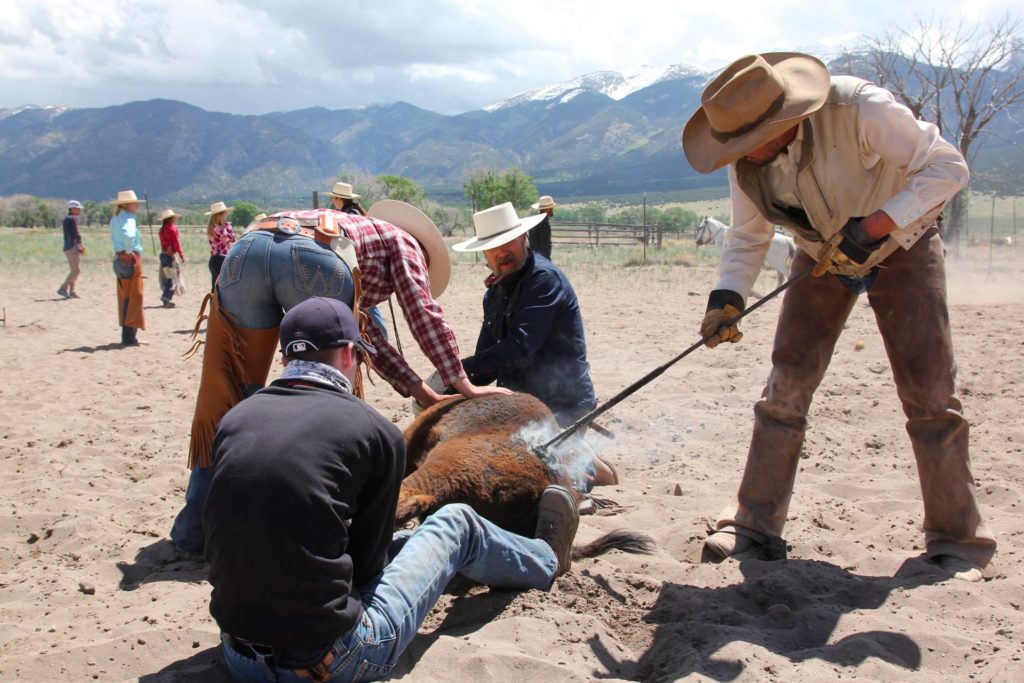
Off with the testicles and on with the Ranchlands brand
I watch this process repeated with a few calves until I feel satisfied that I know the choreography of the wrestling. As with everything at Zapata Ranch, the guests are not palmed off with unimportant or minor jobs – they are out there wrestling the cows, injecting and ear-tagging, though castrating and branding are left to the experts. I move forward with Kaityln and Megan and we wait for Kate to bring a calf in. It is bucking like crazy and it is big enough that a kick looks like it would hurt. When it is close enough we rush forward and Megan and I grab the back leg and lift it as Kaitlyn pulls it down from the front. When the calf is down on the floor Megan shows me how to wedge one foot into its hip whilst pulling back the leg so it can’t move. Then suddenly the team are upon us. It is a male calf so Maddy comes and castrates it and I see a flash of pink as she throws the testicles into the sand. The smell of singed hair gets into my nostrils as the calf is branded. Then someone shouts, ‘Get back,’ and I quickly spring to my feet and watch as the calf runs off, my heart beating fast from the adrenaline.
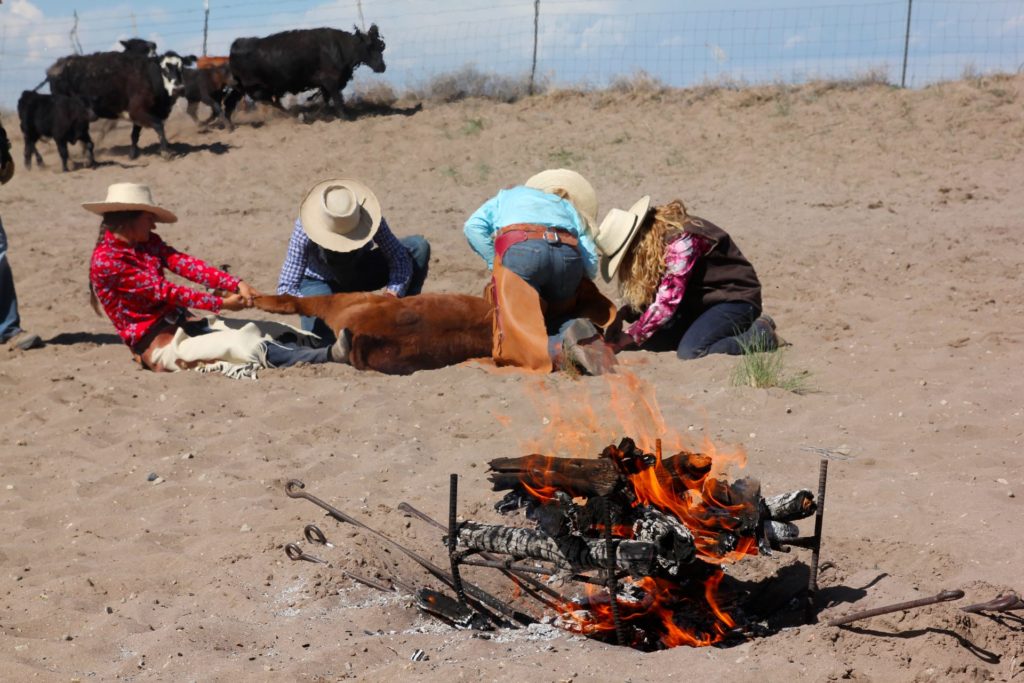
Plenty of irons in the fire at Zapata
I help with a few more calves and then it is lunchtime. We eat bowls of chilli and rest in the shade of the wagon. Duke offers me something like a meatball and I ask what it is…he tells me with a wry smile that is a barbecued testicle – a Rocky Mountain Oyster. I know I should eat it for the cultural experience, but I’m half way through a delicious piece of carrot cake and really, I just can’t bring myself to do it. I chat to Duke about Ranchlands. It is obvious he is the real deal. And he has a vision for Ranchlands beyond the raising of cattle. The idea behind running ranch holidays for example, is not just for the sake of business diversification, though important, it is also because he believes that in order for ranching to survive as a tradition and way of life, people need to be invited to see how it works, especially young urban people. At the same time, fortunately, there has been a huge rise in interest from this demographic in where their food comes from – these are the same people from New York and L.A who eat out and for whom it is important which bakery makes their bread, which farm grows their vegetables and who care that their meat comes from a supplier with high welfare standards. These are also people who might work in the tech industry and have more time off, more disposable income and an appetite for adventure and a different kind of holiday. It makes a lot of sense.
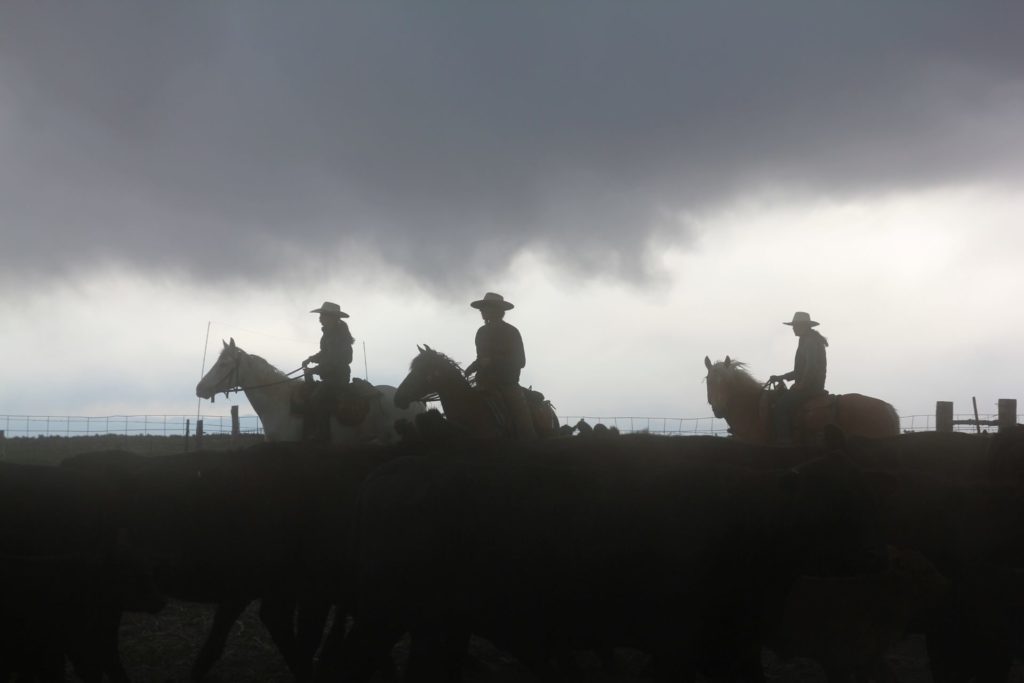
Racing to round up the cattle at Zapata Ranch as storm clouds gather
We finish branding the calves just as a huge rainstorm moves in and turns the air almost black. The horses push the herd back out into the pasture where presumably the calves will get over their trauma and live out their days grazing alongside their mothers. Everyone is exhausted, but exhilarated as we make our way back to the ranch. The spectacle of branding day played out against the backdrop of the Sangre de Cristos is something that I will never forget, a real slice of American culture that will be etched – viscerally so – into my memory forever.
Sample Itinerary: Luxury Family Adventure in Colorado
Laura Kaye is a television producer and author based in London. Her debut novel, English Animals, was published in March 2017.
TO START PLANNING YOUR OWN TAILOR-MADE ROAD TRIP TO COLORADO PLEASE GET IN TOUCH
